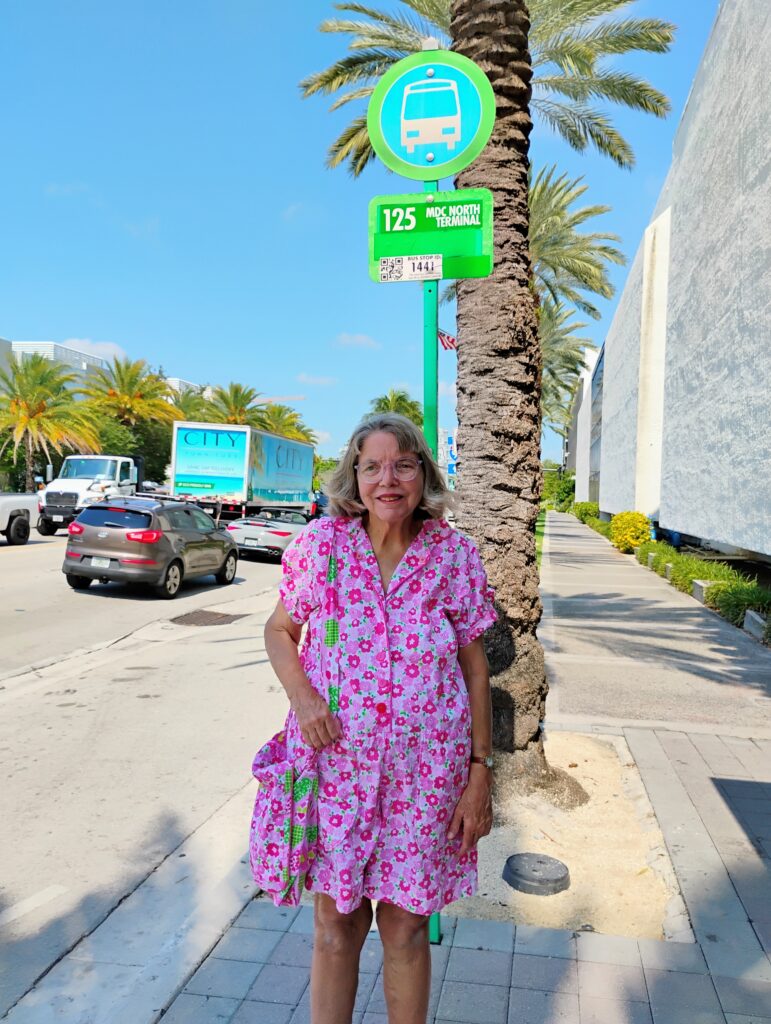To quote the Grateful Dead, “What a long, strange trip it’s been.” That’s the way I feel about my 66 years of riding the bus in Miami.
In other major urban hubs, like Chicago, New York, Washington and Atlanta, commuting is socially accepted and commonplace. But here in Miami, I’ve always felt there is a certain stigma to being a non-driver. I’ve felt this way since childhood.
I began riding the bus at age 6 in 1959. My mother had me ride daily after school from Van E. Blanton Elementary to Little River Library where she worked. I was so small I had to stand on tiptoe to put my dime in the coin box. Bus fares for children were 10 cents and 27 cents for adults. The fare-coin boxes were illustrated with praying hands that read, “Lord – what wilt thou have me to do?” and “All colored move to the back of the bus.” To a tiny schoolgirl just learning to read, it seemed a mixed message.
Even the bus advertisements reflected that discriminatory era, from the oppressive “Playtex Living Girdles make you look 5 pounds thinner” to “Be a Marlboro man!”
Time brought change. The era of Rosa Parks, John F. Kennedy, Lyndon Johnson and the 1964 Civil Rights Act ended segregation of riders. Even the sexist culture of America was undergoing a “metamorphosis.” Fewer women felt the need to wear constricting girdles and smoking became less definitive of “manliness.” However, despite advances of equality regarding race and gender, I feel there has always been a culture of discrimination against non-drivers. But bus riders fought for their rights! Here are some examples in Miami’s history:
In 1963, Little River’s government leaders proposed that all bus benches along 79th Street, from N.W. 7th Avenue to Biscayne Boulevard be eliminated “because they take away the prettiness of our thriving shopping district of department stores, dime stores, banks, drugstores and movie theaters.” Shoppers, workers and housewives, black and white, protested, saying, “After a long day’s work on our feet, we need to sit down when waiting for the bus!” City leaders hastily backed down.
In 1969, bus fares had climbed to 35 cents for adults and 15 cents for students. The County proposed the student fare be applicable only on school days from 7:30 a.m. to 4:30 p.m. This meant students would be paying 20 cents more per ride during off hours. (20 cents might not sound like much today, but in perspective, a candy bar back then was a nickel, and a ticket to see the Doors concert was $6.00). Parents and students howled in protest and student fare stayed in place regardless of time of day.
In 1985, the Miami-Dade County proposed “Network 86,” with massive bus cutbacks called “streamlining.” I became a “Network 86 Forum Participant,” encouraging fellow bus riders to attend a town meeting. Most of my neighbors and fellow passengers were white, elderly and Jewish, (in sharp contrast to North Dade’s current population, which is primarily Haitian and Creole speaking). Network 86 participants eagerly protested at North Miami City Hall, exclaiming “We lived through famines, World War II and the Holocaust! We won’t be swept under the rug by you young whippersnappers with cars!” We all calmed down, heard each other’s viewpoints and compromised. One agreement was that since Routes “10” and “12” were almost identical, the “12” was eliminated. There was even a pleasant surprise: we’d have a new route directly to Aventura Mall! All other North Dade buses remained intact and the proposed cuts were scrapped.
In the 1980s, President Ronald Reagan cut federal transportation funds nationwide and singled out Miami’s Metrorail, saying it would have been “cheaper to buy everyone a limousine.” He, of course, had arrived in Miami in a chauffeured motorcade!
In the summer of 2023, Miami-Dade County made their so-called “exciting” announcement: There’d be a “Better Bus Network,” with ‘more efficient, streamlined service.”
However, seeing their new Route Map, I was shocked! Routes 2, 10, 16, 19, 93 and 297 had been cut. In addition, they curtailed Route 3 so it no longer serves a vast area of North Miami Beach. What does this mean for North Dade commuters? Without the routes listed above, only the 9 remains to travel between downtown and the 163rd Street Mall terminal. Most North Dade riders now have to walk as far as a mile to catch the one remaining 9. It is so crowded bus drivers often have to bypass people waiting at stops. I have heard similar cutbacks have also occurred in other parts of Miami Dade County.
I will not give up hope that the voices of riders will be heard. A Facebook page, “Miamians Against the Better Bus Network,” has been created. There are now 465 members protesting the cutbacks. I hope that more Haitians will join in the protest, as they would be powerful allies. To date, the County has not reinstated the cut routes.
What a long, hard road it has been. The journey continues!

